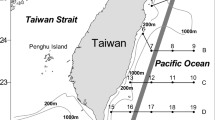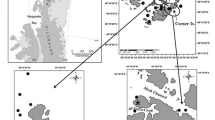Abstract
Flyingfishes are large enough to eat zooplankton, small enough to be consumed by top predators, and therefore form a central mid-trophic component of tropical epipelagic marine food webs. Characterizing patterns of flyingfish abundance, distribution, and habitat preference has important implications for understanding both localized and generalized functions of marine ecosystems. The eastern tropical Pacific Ocean (ETP) supports many flyingfish species and their predators, yet no studies to date have identified oceanographic factors that define flyingfish habitats or estimate species richness and diversity at broad taxonomic and geographic scales. In this study, we analyzed 11,125 flyingfish representing 25 species and all seven named genera, collected from the ETP over a 21-year period. We applied spatially explicit analysis methods (ARCGIS, DIVA-GIS, MAXENT) and compared specimen locality data to remotely sensed oceanographic data and previously described oceanographic partitions. Our results show that Exocoetus is the most abundant genus (49%) and E. monocirrhus the most abundant species (32%) of flyingfishes in the ETP. Mean sea surface temperature was most important for defining flyingfish habitats (19.2–41.7%) and species richness (highest in the North Equatorial Current). Additionally, flyingfish species diversity was found to be highest in coastal regions of the study area (Shannon indices > 1.5). Together, these results provide unprecedented characterizations of a mid-trophic epipelagic community in an economically valuable region during a time when sea surface temperatures are predicted to increase as a result of global climate change.




Similar content being viewed by others
References
Angel MV (1993) Biodiversity of the Pelagic Ocean. Conserv Biol 7(4):760–772
Ballance LT, Pitman RL et al (2006) Oceanographic influences on seabirds and cetaceans of the eastern tropical Pacific: a review. Prog Oceanogr 69(2):360–390
Block BA, Dewar H et al (2001) Migratory movements, depth preferences, and thermal biology of Atlantic bluefin tuna. Science 293(5533):1310–1314
Cadotte MW, Jonathan Davies T et al (2010) Phylogenetic diversity metrics for ecological communities: integrating species richness, abundance and evolutionary history. Ecol Lett 13(1):96–105
Churnside J, Brodeur R et al (2009) Combining techniques for remotely assessing pelagic nekton: getting the whole picture. In: The future of fisheries science in North America. Springer, Dordrecht, pp 345–356
Clarke A, Gaston KJ (2006) Climate, energy and diversity. Proc R Soc Lond B Biol Sci 273(1599):2257–2266
Collette B, McGowen G et al (1984). Beloniformes: development and relationships. In: Ontogeny and systematics of fishes. pp 335–354
Currie DJ, Mittelbach GG et al (2004) Predictions and tests of climate‐based hypotheses of broad‐scale variation in taxonomic richness. Ecol Lett 7(12):1121–1134
Davenport J (1994) How and why do flying fish fly? Rev Fish Biol Fish 4(2):184–214
Elith J, Phillips SJ et al (2011) A statistical explanation of MaxEnt for ecologists. Divers Distrib 17(1):43–57
Fernández-Álamo MA, Färber-Lorda J (2006) Zooplankton and the oceanography of the eastern tropical Pacific: a review. Prog Oceanogr 69(2):318–359
Fiedler PC, Lavín MF (2006) Introduction: a review of eastern tropical Pacific oceanography. Prog Oceanogr 69(2):94–100
Fraser RH, Currie DJ (1996) The species richness-energy hypothesis in a system where historical factors are thought to prevail: coral reefs. Am Nat 148:138–159
Grudtsev M, Salekhova L et al (1987) Distribution, ecology and intraspecific variability of flyingfishes of the genus Exocoetus of the Atlantic Ocean. J Ichthyol 27:39–50
Gutiérrez D, Bouloubassi I et al (2011) Coastal cooling and increased productivity in the main upwelling zone off Peru since the mid‐twentieth century. Geophys Res Lett 38(L07603):1–6
Hijmans R, Guarino L et al (2005) DIVA-GIS Version 5.2 A geographic information system for the analysis of biodiversity data. Manual. Available from http://www.diva-gis.org
Keeling RF, Körtzinger A et al (2010) Ocean deoxygenation in a warming world. Mar Sci 2:199–229
Lewallen EA, Pitman RL et al (2011) Molecular systematics of flyingfishes (Teleostei: Exocoetidae): evolution in the epipelagic zone. Biol J Linn Soc 102(1):161–174
Longhurst AR, Pauly D (1987) Ecology of tropical oceans. Academic, San Diego
McGill BJ, Etienne RS et al (2007) Species abundance distributions: moving beyond single prediction theories to integration within an ecological framework. Ecol Lett 10(10):995–1015
Nesterov A, Bazanov S (1986) Vertical distribution and behavior of flyingfish (Exocoetidae). J Ichthyol 26(5):159–162
Nesterov A, Grudtsev MY (1981) The quantitative distribution of flyingfish of the family Exocoetidae (Beloniformes) in the tropical Atlantic. J Ichthyol 20:137–140
Oxenford H (1994) Movements of flyingfish (Hirundichthys affinis) in the eastern Caribbean. Bull Mar Sci 54(1):49–62
Oxenford H, Mahon R et al (1995) Distribution and relative abundance of flyingfish (Exocoetidae) in the eastern Caribbean. I. Adults. Mar Ecol Prog Ser Oldendorf 117(1):11–23
Parin N (1961) Principles of classification of flying fishes (Oxyporhamphidae and Exocoetidae). Trudy Inst Oceanol 43:92–183
Parin N (1968) Ichthyofauna of oceanic epipelagic zone. Nauka Press, Moscow
Parin N (1981) Quantitative distribution of flying fishes in the east equatorial pacific from visual counting data. Okeanologiya 21(5):903–910
Parin NV (1983) Assessment of the abundance of flying fishes by visual observations. Biol Oceanogr 2(2–4):341–355
Parin N (1995) Exocoetidae. Peces voladores. Guia FAO para Identification de Especies para lo Fines de la Pesca. Pacifico Centro-Oriental 3:1091–1103
Parin N (1996) On the species composition of flying fishes (Exocoetidae) in the west-central part of tropical Pacific. J Ichthyol 36(5):357–364
Parin N (1999) Exocoetidae. Flyingfishes. FAO species identification guide for fishery purposes. The living marine resources of the West Central Pacific 4:2162–2179
Parin N, Belyanina T (1998) Age and geographic variability and distribution of the flying fish Cheilopogon furcatus (Exocoetidae, beloniformes), with a description of two new sub species. J Ichthyol 38(8):557–573
Parin N, Belyanina T (2002a) Flying fishes of the genus Fodiator (Exocoetidae): systematics and distribution. J Ichthyol 42(5):357–367
Parin N, Belyanina T (2002b) A review of flyingfishes of the subgenus Danichthys (genus Hirundichthys, Exocoetidae). J Ichthyol 42(1):S23
Parin N, Shakhovskoy I (2000) A review of the flying fish genus Exocoetus (Exocoetidae) with descriptions of two new species from the southern Pacific Ocean. J Ichthyol 40(1):S31
Pennington JT, Mahoney KL et al (2006) Primary production in the eastern tropical Pacific: a review. Prog Oceanogr 69(2):285–317
Phillips SJ, Dudík M (2008) Modeling of species distributions with Maxent: new extensions and a comprehensive evaluation. Ecography 31(2):161–175
Phillips SJ, Anderson RP et al (2006) Maximum entropy modeling of species geographic distributions. Ecol Model 190(3):231–259
Rau G, Mearns A et al (1983) Animal C/C correlates with trophic level in pelagic food webs. Ecology 64(5):1314–1318
Rohde K (1992) Latitudinal gradients in species diversity: the search for the primary cause. Oikos 65:514–527
Shakhovskoy I (2007) Skull structure of the flying fish Cheilopogon pinnatibarbatus (Beloniformes, Exocoetidae). J Ichthyol 47(4):259–266
Shakhovskoy I, Parin N (2010) A comparative description and distribution of the flying fishes—Cypselurus poecilopterus, C. simus, and C. callopterus, sorted out into the species group of spotwing species of the subgenus Poecilocypselurus. J Ichthyol 50(8):559–579
Smith AD, Brown CJ et al (2011) Impacts of fishing low-trophic level species on marine ecosystems. Science 333(6046):1147–1150
Steven EC, Oxentord A et al (1993) Radiochemical determination of longevity in ilyingiish Hirundichthys affinis using Th-228/Ra-228. Mar Ecol Prog Ser 100:211–219
Tittensor DP, Baco AR et al (2010a) Seamounts as refugia from ocean acidification for cold‐water stony corals. Mar Ecol 31(s1):212–225
Tittensor DP, Mora C et al (2010b) Global patterns and predictors of marine biodiversity across taxa. Nature 466(7310):1098–1101
Tyberghein L, Verbruggen H et al (2012) Bio‐ORACLE: a global environmental dataset for marine species distribution modelling. Glob Ecol Biogeogr 21(2):272–281
Valavanis VD, Kapantagakis A et al (2004) Critical regions: a GIS-based model of marine productivity hotspots. Aquat Sci 66(1):139–148
Watanabe C, Yatsu A (2004) Effects of density-dependence and sea surface temperature on interannual variation in length-at-age of chub mackerel (Scomber japonicus) in the Kuroshio-Oyashio area during 1970–1997. Fish Bull 102(1):196–206
Weber E, McClatchie S (2010) Predictive models of northern anchovy Engraulis mordax and Pacific sardine Sardinops sagax spawning habitat in the California Current. Mar Ecol Prog Ser 406:251–263
White EP, Ernest SM et al (2007) Relationships between body size and abundance in ecology. Trends Ecol Evol 22(6):323–330
Zwolinski JP, Emmett RL et al (2011) Predicting habitat to optimize sampling of Pacific sardine (Sardinops sagax). ICES J Mar Sci J Conseil 68(5):867–879
Acknowledgements
We thank Robert Pitman for sharing his expertise and graciously donating flyingfish specimens and field collection data throughout the course of this study. Additionally, J. Cotton and J.C. Salinas assisted specimen collection efforts, although many others were involved in dipnetting flyingfishes. In particular, we thank the Protected Resources Division of the NOAA Southwest Fisheries Science Center for allowing specimens to be collected during oceanographic studies. Specimen handling and preservation were facilitated by the Scripps Institution of Oceanography (H.J. Walker and P. Ajtai), the Royal Ontario Museum (E. Holm, F. Pardo, M. Burridge, and D. Stacey), and the University of Toronto at Scarborough (D. Xiao, M. Huang, and J. Gordon). Funding for this project was provided by an NSERC Discovery Grant (N. Lovejoy), University of Toronto Doctoral Completion Award (E. Lewallen), and NIH-NIAMS Ruth L. Kirschstein National Research Service Award (F32 AR68154; E. Lewallen). We also thank J. Redfern, T. Moore, and J. Knouft for advice regarding spatial analysis methods. Helpful comments on how to improve this manuscript were provided by P. Hastings, R. Winterbottom, A. Mason, C. Healy, and anonymous comments provided during journal peer review.
Author information
Authors and Affiliations
Corresponding authors
Ethics declarations
Ethical approval
All applicable international, national, and/or institutional guidelines for the care and use of animals were followed.
Additional information
Communicated by R. Serrao Santos
Appendix
Appendix
Rights and permissions
About this article
Cite this article
Lewallen, E.A., van Wijnen, A.J., Bonin, C.A. et al. Flyingfish (Exocoetidae) species diversity and habitats in the eastern tropical Pacific Ocean. Mar Biodiv 48, 1755–1765 (2018). https://doi.org/10.1007/s12526-017-0666-7
Received:
Revised:
Accepted:
Published:
Issue Date:
DOI: https://doi.org/10.1007/s12526-017-0666-7




